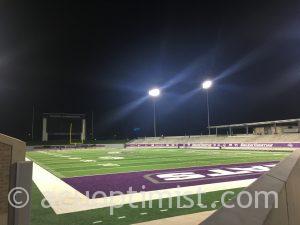Though ACU is doing a commendable job at reducing energy waste with more efficient air conditioning and heating methods, there is still a bright elephant in the room: the constantly illuminated football stadium.
Coming from a high school with a $60 million football stadium that holds 18,000 people, I understand the excitement that comes with having a giant stadium. However, our stadium lights were only on for night football games and for practices in the dark when the sun set at an early time.
Yet, Wildcat Stadium is always brightly shining.

A picture from 7:43 p.m., which shows the field lights on despite the stadium not being in use. (Photo by Allayna Ford)
I’m not just talking about the field lights, because those will get turned off a few times here and there. I am talking about the suites and press level constantly being lit.
The average stadium takes 35,000 watts to power it. Multiplying that by 13 cents, the average cost of electricity in Abilene, and dividing it by 1000 leaves you with $4.55, which is the cost it takes to power those lights per hour. The sun sets around 6:50 p.m. and rises around 8 a.m., meaning the lights are on for 13 hours. The total amount it would take for the lights to remain on for one night is $59.15 and $3,321.50 for one month.
These numbers are a guesstimate, but the cost would be roughly around that amount.
If the university wants to cut costs and be more energy efficient, shutting down the stadium is an area that must be addressed. If they have a deal with the cost of stadium energy priced at an incredibly small cost, I would be more understanding about the excess usage, but to my knowledge, the school is charged for all energy usage.
I understand football players practice at night, and they shouldn’t have to practice in the dark, but clearly they don’t practice every hour of every night, at least not as long as the lights stay on.
I also know ACU is proud of its new stadium, and I might understand their desire to show off the Anthony Field sign by keeping it lit, but there are unnecessary lights on in Chuck Sitton Tower and on the field.
The money to pay the electricity bills must come from somewhere, which makes me wonder who is paying for the lights to be constantly on. Even if the money isn’t being pulled from students’ tuition, it is being pulled from somewhere. Regardless of who has the budget, this money could be spent in better ways to directly assist student athletes.
Despite the positive move to conserve energy, I would rather have full control of the temperature in buildings alongside a dark stadium, versus having extreme temperatures and a bright field.
